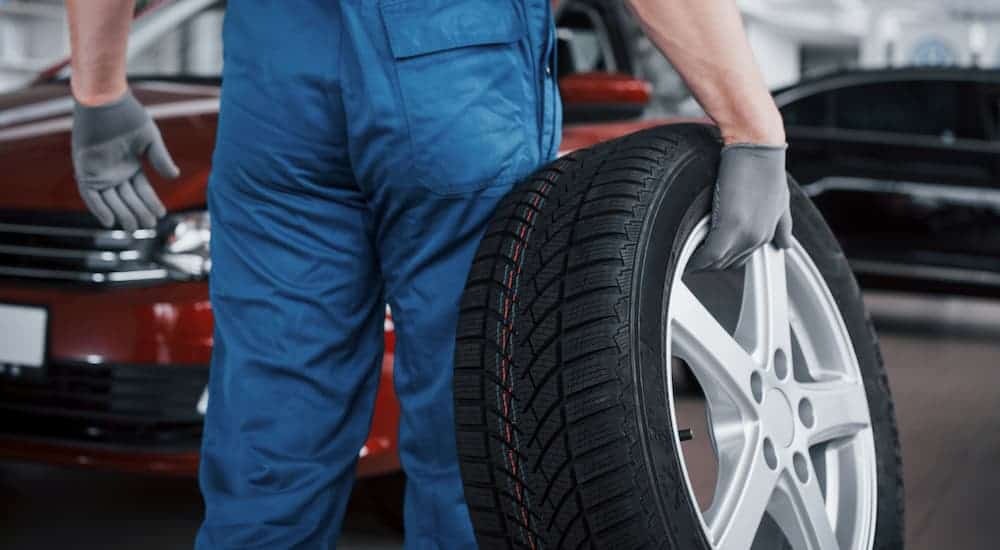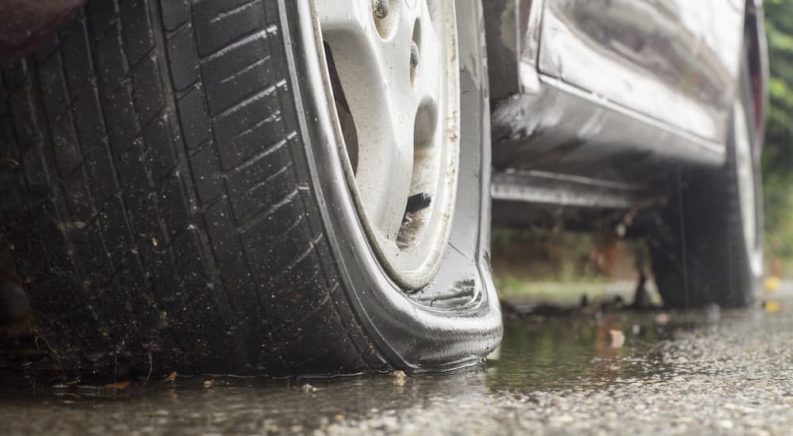A flat tire can quickly ruin your day, whether it occurs right before you head into work in the morning or you discover it after a fun right out with friends. Either way, the flat must be fixed before you can get back on the road and to a reputable tire shop that can ensure the tire is safe for long-term driving. While many cars come with a spare tire, sometimes a spare isn’t always available, and that leaves many to turn to another option—plugging the tire. So, what is the best way to plug a tire? The best way to plug a tire is with a patch plug that works as a two-way permanent repair.
The patch plug is unique because it works on both the interior and exterior of the tire. The patch works from the inside and features a built-in rubber plug that creates an interior and exterior seal when pulled through the hole. Let’s take a closer look at the process as well as the differences between repairable and non-repairable tires, the safest methods of repair, and more.
Repairable and Non-Repairable Tires
Not all tires can be repaired, which is why it’s important to know the basics of whether a tire can be safely repaired before you get back on the road and head to your local tire shop. The general rule of thumb is that a tire with a puncture that measures less than 1/4-in in diameter and is not located on the sidewall or the shoulder can usually be repaired. However, tires with previous holes and repairs cannot safely be repaired if the new puncture overlaps with, or is directly across from, the previous puncture.
There is one other indicator that a tire cannot be safely repaired. If there is a bulge or bubble in the sidewall, this indicates damage that’s usually caused by road hazards like potholes and curbs. This bubble or bulge means the tire is not repairable and must be immediately discontinued from use.

Why Tire Plugs and Patches Don’t Work Well Alone
It’s common to use a tire plug to repair a flat tire, but this is not recommended because it can be extremely hazardous to drivers who don’t know the proper method. Plugging a tire is more than jamming it through the tire’s tread and getting back on the road. To properly repair a tire, the interior and exterior of the tire must be inspected, which means the tire needs to be taken off the rim. It’s not as easy as “plug and go.”
Another common mistake in repairing a tire is fixing it with a simple patch. This creates another hazard because if the patch is applied to the exterior, there’s no guarantee that the interior is also sealed or patched. The same issue occurs with a plug—a plug inserted through the exterior seals the exterior but does not necessarily seal the interior. A quick visual inspection may lead you to believe the tire is repaired, but there could be an undetected leak or further problems.

The Best of Both Worlds: Patch Plugs
Patches and plugs fall short when used by themselves, but a patch plug is a safer and more permanent option that seals the tire’s interior and exterior. It also forces you to inspect both the tire’s interior and exterior rather than merely plugging or patching the tire and hoping it holds until you reach the tire shop. Because of this, applying a patch plug takes a little more time and effort, but it’s worth it in the long run.
The first step in the repair process is to remove the tire and thoroughly inspect the interior and exterior. This is important because damage can occur in more than one area, depending on the culprit (ex: a nail, screw, road hazard, etc.). Once you’ve located the damage, determine if the tire is repairable by asking yourself these questions:
- Does the puncture measure less than 1/4-in in diameter? If so, the tire is repairable, depending on the following questions.
- Is the puncture located on the sidewall or within 1-in to 1.5-in from the shoulder? If so, it cannot be repaired.
- Is the puncture located directly across from or in the same area as a previous puncture or repair? If so, the tire cannot be repaired.
- Does the tire have a bulge or bubble near the sidewall? If so, the tire cannot be repaired.
Once you determine the tire is repairable, clean and stabilize the punctured area by removing any damaged cables or debris. Remove the plug patch from its packaging and insert it into the punctured area. Test the patch to ensure it fully covers the exposed area by pulling the rubber plug through the puncture with your fingers or a pair of pliers.
After testing the patch plug to ensure it fits the area, buff the interior of the puncture site and use the rubber vulcanizing glue provided with the patch plug. Note that some patch plugs come pre-glued and only require you to peel the top layer off the patch to expose the adhesive. Once the glue is applied or exposed, line up the patch by pulling the plug with a pair of pliers. The glue chemically reacts to the tire and causes the patch to seal the interior and the plug to seal the tire’s exterior.
Once the patch plug is in place, mount the tire back on the rim. Inflate the tire to the appropriate pressure, which is notated on the tire or in the vehicle’s owner’s manual. By inflating the tire, you can then check for any noticeable leaks to the repaired area.
The Importance of Properly Repairing a Flat Tire
Flat tires usually occur at the most inopportune times, but that does not mean the repair should be rushed or hurried. It is imperative that, whether you do the repair yourself or rely on a reputable tire shop, that the repair is not a quick fix but a safe, long-term solution that will not cause further damage to the tire or worse—to you. A tire that is not repaired correctly can be a life or death hazard.
Tires that are not adequately repaired can cause extensive damage to the tire over time. This results in deterioration that can lead to failure, which is hazardous at high speeds. Imagine driving down the highway at 70 mph only to have the tire fail, causing you to lose control of the vehicle. This could lead to a tragic accident that could have been avoided with a proper repair.
If you find yourself with a flat tire, remember that the best way to plug a flat tire is to take your time, ensure the tire is repairable, and use a patch plug. Patch plugs offer a twofold solution that seals the interior and the exterior of the tire. This solution is not only safe; it can be permanent when properly applied by dismounting and inspecting the tire before using the patch plug. If you have any doubts about if the tire is safe, you can always take it to a nearby tire shop for further inspection or to buy a replacement.

